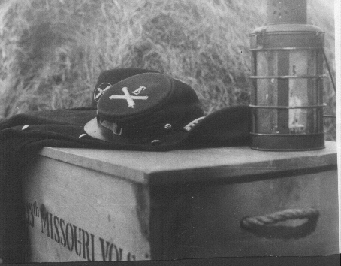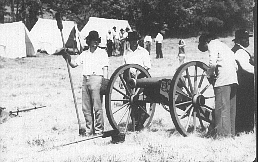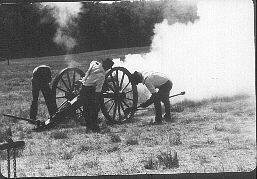|
|
|
From August to the end of October 1980, I was part of Steve Lillard's pet project: The 1st Missouri Light Artillery, Battery E. In these 3 short months, I attended some exciting events, learned a little about Missouri history, and witnessed some memorable if not hilarious episode's.
Wilson's Creek - Aug 9-10
 Just barely into August, Steve invited me to a living history event at Wilson's Creek. I had never heard of the place (remember, I was still learning about the Civil War in Missouri). Steve said it was near Springfield, and we would be doing an encampment on the original battlefield. By living history, Steve said we would be only doing firing demonstrations and learning the cannon drill. He explained that since Wilson's Creek was owned by the United States Park Service, it was taboo to do a 'mock battle' like we had done at Glasgow. Some battlefield sites are owned by the city, some by the state. Those that are owned by Uncle Sam are considered sacred grounds and therefore off limits to 'wargamers' and any firing demonstartions are strictly monitored by the Park Rangers. ( Only recently have reenactors been allowed to attend these National Park sites and participate in living history program's aimed at educating the public about the Civil War.) We were taking our first baby steps in establishing a living history program in Missouri. Even more serious for us was the fact that this was the 119th anniversary of the Battle of Wilson's Creek We didn't want to fuck it up.
Just barely into August, Steve invited me to a living history event at Wilson's Creek. I had never heard of the place (remember, I was still learning about the Civil War in Missouri). Steve said it was near Springfield, and we would be doing an encampment on the original battlefield. By living history, Steve said we would be only doing firing demonstrations and learning the cannon drill. He explained that since Wilson's Creek was owned by the United States Park Service, it was taboo to do a 'mock battle' like we had done at Glasgow. Some battlefield sites are owned by the city, some by the state. Those that are owned by Uncle Sam are considered sacred grounds and therefore off limits to 'wargamers' and any firing demonstartions are strictly monitored by the Park Rangers. ( Only recently have reenactors been allowed to attend these National Park sites and participate in living history program's aimed at educating the public about the Civil War.) We were taking our first baby steps in establishing a living history program in Missouri. Even more serious for us was the fact that this was the 119th anniversary of the Battle of Wilson's Creek We didn't want to fuck it up.
Steve came to my apartment that Friday afternoon, with Richard Savage and the cannon, and we soon headed south on 71 Hwy. After a few hours, and on the other side of Springfield, we entered the park property. We made our way down a rough-cut road, which was in fact part of the old Telegraph Road (this road was cut many years prior to the Civil War and was used as an avenue for travelers passing through Missouri and into Arkansas ). A wood planked bridge spanned the shallow creek, which was maybe 30 feet across, at its widest. After about an hour, it was decided that all the artillery would be on the other side of the creek. The federal's would camp by themselves on this side. So, we had to move everything back across, where we set up out tents near the reb infantry. There were a total of 4 guns, including ours, and we were all located at the exact spot were the Missourians had camped on the evening of August 9, 1861. Higginbotham and his wife Gail drove to the event in their little Ford Cougar and arrived sometime before evening set.
If I recall correctly, the visitors who came to see us, watch us do our drill, etc., came by 'invitation only'- people connected with or friends of the park service, historian's, state politician's, etc. At that time, the visitor's center for the Wilson's Creek National Battlefield site was housed in a mobile home. Federal funding was trickling in for a modern building, but donations were gladly accepted. Those that were able to donate generously, naturally received special consideration in viewing the living history program this weekend.
 When we began to drill with the cannon the next morning, it was my understanding that I would be the number 1 man. My duties included loading the cannon, by pushing one of Steve Lillard's black powder filled tin foil balls into the cannon with a ram rod. After the cannon had been fired, I was to use a 'worm', a long wooden staff with curled metal prongs on its end, to extract any pieces of tin foil left in the tube. After that a different ramrod was used. It had thick pieces of carpet wrapped around both ends, making it look like a giant Q-TIP. One end was dipped into a metal bucket of tepid creek water, the excess wrung off in a motion similar to a dog shaking water off its back. The dampened end of this ramrod was thrust into the tube to extinguish any burning embers. Then this same ramrod was reversed and the dry end was thrust in sop up the excess water. I must mention that while these house cleaning chores were being done to the inside the tube, Richard Savage had one leather encased thumb over the vent hole. By sealing off this vent hole while I worked the ramrod, a vacuum was being created as well. When the ramrod was pulled from the tube, a hollow sounding 'THUNK' occurred. Whatever the worm or water missed, the creation of a vacuum within the tube ended the life of any would be spark. It was necessary that this procedure be repeated each and every time the cannon was fired. We were simply following the same procedures as the ancient artillerymen of 119 years ago had done.
When we began to drill with the cannon the next morning, it was my understanding that I would be the number 1 man. My duties included loading the cannon, by pushing one of Steve Lillard's black powder filled tin foil balls into the cannon with a ram rod. After the cannon had been fired, I was to use a 'worm', a long wooden staff with curled metal prongs on its end, to extract any pieces of tin foil left in the tube. After that a different ramrod was used. It had thick pieces of carpet wrapped around both ends, making it look like a giant Q-TIP. One end was dipped into a metal bucket of tepid creek water, the excess wrung off in a motion similar to a dog shaking water off its back. The dampened end of this ramrod was thrust into the tube to extinguish any burning embers. Then this same ramrod was reversed and the dry end was thrust in sop up the excess water. I must mention that while these house cleaning chores were being done to the inside the tube, Richard Savage had one leather encased thumb over the vent hole. By sealing off this vent hole while I worked the ramrod, a vacuum was being created as well. When the ramrod was pulled from the tube, a hollow sounding 'THUNK' occurred. Whatever the worm or water missed, the creation of a vacuum within the tube ended the life of any would be spark. It was necessary that this procedure be repeated each and every time the cannon was fired. We were simply following the same procedures as the ancient artillerymen of 119 years ago had done.
 Throughout the daylight hours of Saturday and the early afternoon of Sunday, we practiced loading and firing the cannon - usually in concert with the other guns that were there. All guns would volley fire together in one exercise, then we'd fire back to back, one after the other. When beginning the drill, each group of four men would stand about ten paces behind their gun. At the command, "CANNONEERS POST!", each group would walk forward and assume his assigned position at his gun. Like I said, mine was position number 1. Higginbotham was the number 2 man. He basically brought the tin foil round from the limber, placed it in a leather haversack, showed the round to Steve, who was the gun captain. After Steve inspected the round, Hig brought the round to the front of the tube, and placed it by hand just inside the tube for me to ram. I think Richard Savage's number was 3. As mentioned in last chapter, he worked the vent, brushed it out, punctured tin foil bag, set primer, and lanyard. He also helped Steve aim the piece left, right, or up, down. Finally, it was Steve's task to jerk the lanyard.
Throughout the daylight hours of Saturday and the early afternoon of Sunday, we practiced loading and firing the cannon - usually in concert with the other guns that were there. All guns would volley fire together in one exercise, then we'd fire back to back, one after the other. When beginning the drill, each group of four men would stand about ten paces behind their gun. At the command, "CANNONEERS POST!", each group would walk forward and assume his assigned position at his gun. Like I said, mine was position number 1. Higginbotham was the number 2 man. He basically brought the tin foil round from the limber, placed it in a leather haversack, showed the round to Steve, who was the gun captain. After Steve inspected the round, Hig brought the round to the front of the tube, and placed it by hand just inside the tube for me to ram. I think Richard Savage's number was 3. As mentioned in last chapter, he worked the vent, brushed it out, punctured tin foil bag, set primer, and lanyard. He also helped Steve aim the piece left, right, or up, down. Finally, it was Steve's task to jerk the lanyard.
I neglected to mention our dress. While on the confederate side, we had to shuck our blue sack coats and forage caps. We worked in our shirt sleeves, Hig borrowed a civilian coat from somebody. For headgear, while the other fellows had a black slouch hat to wear, I was loaned a derby hat. As this was merely a living history weekend and an entertainment for visitors when they showed up, nothing else noteworthy occured while at Wilson's Creek. But it was an education for me, and a trip I enjoyed making.